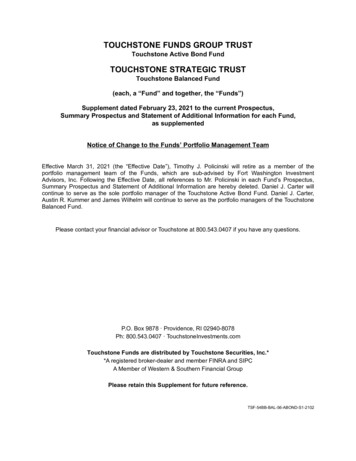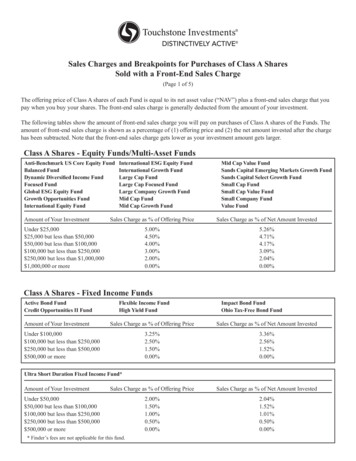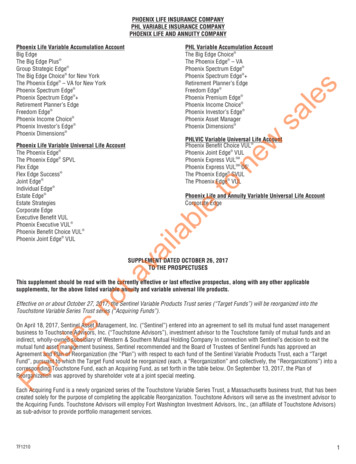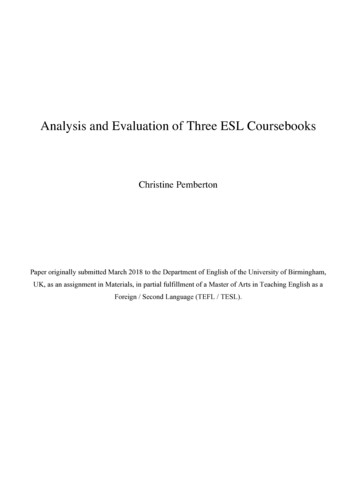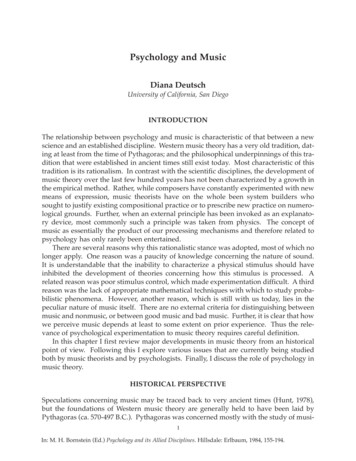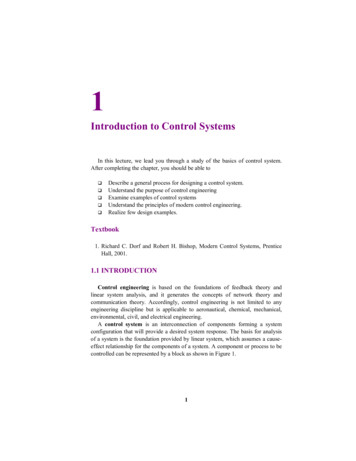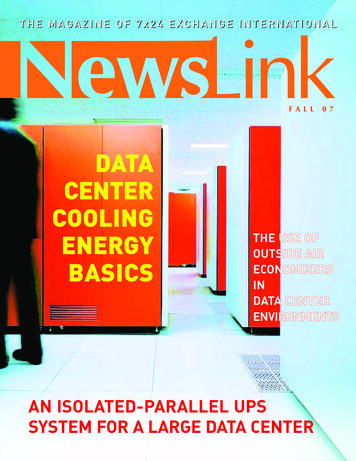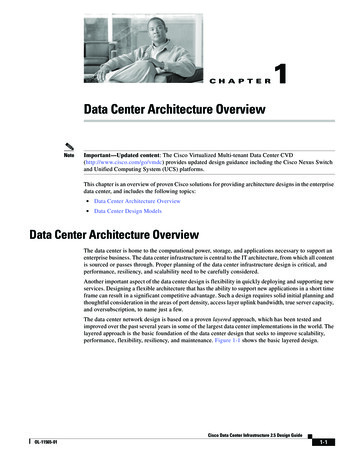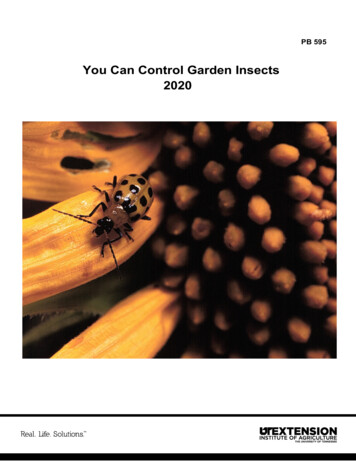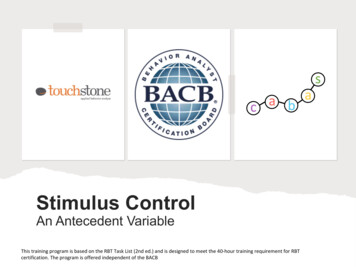
Transcription
Stimulus ControlAn Antecedent VariableThis training program is based on the RBT Task List (2nd ed.) and is designed to meet the 40-hour training requirement for RBTcertification. The program is offered independent of the BACB
References Cooper, J. O., Heron, T. E., & Heward, W. L. (2020). Applied Behavior Analysis (3rd ed.). Hoboken, NJ: Pearson. Behavior Analyst Supervisor (BAS) RBT Study Guide https://behavioranalystsupervisor.com/ RBT Task List (2nd Edition) https://www.bacb.com/rbt/
In This PresentationC-7 Implement Discrimination TrainingC-8 Implement stimulus control transfer procedures procedures
What is Stimulus Control“A situation in which the frequency, latency, duration, oramplitude of a behavior is altered by the presence orabsence of an antecedent stimulus,” (Cooper et al., 2020)A specific set of conditions that evokes a particularresponse.
Stimulus Control Stimulus control is acquired when– Responses are reinforced only in thepresence of a specific stimulus Known as the discriminative stimulus (SD)– And not in the presence of other stimuli Known as stimulus deltas (SΔ)Cooper, Heron, and HewardApplied Behavior Analysis, Second EditionCopyright 2007 by Pearson Education, Inc.All rights reserved
Terms to Know Discriminative Stimulus (SD)– A discriminative stimulus is "a stimulus in thepresence of which a particular response willbe reinforced".(Malott, 2007, p. 202) Stimulus Delta (SΔ) Definition– The stimulus delta is defined as ‘a stimulus inthe presence of which a particular responsewill not be reinforced’ (Malott, 2007, p. 202).
Imagine found tml
Think about what we havelearned so far Reinforcement and extinction of behaviorsare the fundamentals in creating stimuluscontrol. When the stimulus is present, the desiredbehavior is reinforced. When the stimulus is absent, the behavior isignored or put on extinction.
Development of Stimulus Control Stimulus discrimination training– Requires one behavior– Two antecedent stimulus conditions (the SD andthe SΔ) Responses that occur in the presence of theSD are reinforced (thus, the responseincreases in the presence of the SD) Responses that occur in the presence of theSΔ are not reinforced (this, the responsedecreases in the presence of the SΔ)– Can also result in a lesser amount or quality ofreinforcementCooper, Heron, and HewardApplied Behavior Analysis, Second EditionCopyright 2007 by Pearson Education, Inc.All rights reserved
The Development of StimulusControlSDResponseTelephone ringsPick upphone andsay “hello”SΔResponseDoorbell ringsCooper, Heron, and HewardApplied Behavior Analysis, Second EditionPick upphone andsay “hello”SR Copyright 2007 by Pearson Education, Inc.All rights reserved
DSMO
Stimulus Control andMotivating Operations Similarities– Both events occur before the behavior ofinterest– Both events have evocative functions However, they are different!Cooper, Heron, and HewardApplied Behavior Analysis, Second EditionCopyright 2007 by Pearson Education, Inc.All rights reserved
Motivating Operations Remember, a motivating operation issomething that changes the value of astimulus as a reinforcer– Establishing operation (EO) makes thereinforcer more valuable– Abolishing operation (AO) makes thereinforcer less valuableCooper, Heron, and HewardApplied Behavior Analysis, Second EditionCopyright 2007 by Pearson Education, Inc.All rights reserved
Antecedent stimuli that evokebehavior:– Some are SDs, Some are MOs– How do we tell them apart? An SD evokes behavior because areinforcing consequence is moreavailable in its presence than in itsabsence.– There’s always an SΔ as well An MO evokes behavior because theconsequence is more reinforcing inits presence than in its absence– There is no SΔ - the behavior willproduce the consequence regardless ofthe presence or absence of the MO.
More to Come onMotivatingOperations(MOs)
Stimulus Control and StimulusGeneralization are per, Heron, and HewardApplied Behavior Analysis, Second EditionCopyright 2007 by Pearson Education, Inc.All rights reserved
Terms to Know
Stimulus GeneralizationResponding to antecedentstimuli sharing certain aspectsof the original SD; abroadening of the spectrum ofstimuli that occasion certainresponses. The individual responds tosomething in the same waythat resembles the originalthing from which they learned. Same behavior across differenttimes, settings, people, etc.Cooper, Heron, and HewardApplied Behavior Analysis, Second Edition(Imagine from Rouge ABA)Copyright 2007 by Pearson Education, Inc.All rights reserved
Stimulus Discrimination Occurs when newstimuli that aresimilar to thecontrolling stimulusdo not evoke thesame response asthe controllingstimulusCooper, Heron, and HewardApplied Behavior Analysis, Second EditionPeople learn to responddifferently to red, green, andyellow lights; they learn todiscriminate.Copyright 2007 by Pearson Education, Inc.All rights reserved
Implement stimulus control transferprocedures procedures (C8)
Factors Affecting StimulusControl Consistent use of reinforcers contingentupon correct responding in thepresence of the SD is critical Also important are:– Pre-attending skills– Stimulus salience– Masking and overshadowingCooper, Heron, and HewardApplied Behavior Analysis, Second EditionCopyright 2007 by Pearson Education, Inc.All rights reserved
Pre-attending A prerequisite skill for stimulus control– Looking at instructional materials– Looking at teacher when responses aremodeled– Listening to oral instructions– Sitting quietly for short periods of time These may need to be taught beforestimulus control procedures areimplementedCooper, Heron, and HewardApplied Behavior Analysis, Second EditionCopyright 2007 by Pearson Education, Inc.All rights reserved
Stimulus Salience Prominence of the stimulus in theenvironment Increased saliency facilitates efficiencyof instructionCooper, Heron, and HewardApplied Behavior Analysis, Second EditionCopyright 2007 by Pearson Education, Inc.All rights reserved
Masking and Overshadowing Increase or decrease salience of stimuli Competing stimuli may block theevocative function of an SD To limit the negative effects of these:– Rearrange the environment– Make instructional stimuli more intense– Consistently reinforce behavior in thepresence of instructionally-relevant stimuliCooper, Heron, and HewardApplied Behavior Analysis, Second EditionCopyright 2007 by Pearson Education, Inc.All rights reserved
Using Prompts Supplementary antecedent stimuli usedto occasion a correct response in thepresence of an SD (that will eventuallycontrol behavior)– Response prompts operate directly on theresponse– Stimulus prompts operate directly on theantecedent task stimuliCooper, Heron, and HewardApplied Behavior Analysis, Second EditionCopyright 2007 by Pearson Education, Inc.All rights reserved
Transfer of Stimulus Control Prompts should be used only duringacquisition Transfer stimulus control from prompt tonaturally-existing stimuli quickly usingfadingCooper, Heron, and HewardApplied Behavior Analysis, Second EditionCopyright 2007 by Pearson Education, Inc.All rights reserved
Transferring Stimulus Control: ExamplesSomeone shows you two fruits and asks you which one is a banana(stimulus condition)-you chose the banana (correct response)The presentation of the fruit and the question controlled the response(stimulus control) because when you present these the correct answeris given
Transferring Stimulus Control ContinuedSometimes the response is controlled by something other than thestimulus we want.Given our exemple, if you present the two fruit and Jimmy grabs onebefore you present the question simply because he loves that fruit, thenhis response is not under the correct stimulus control, even if hehappened to grab the correct fruit.
Transferring Stimulus Control ContinuedGiven our situation with Jimmy (grabbing the fruit prior to asking thequestion), the therapist must transfer stimulus control.Instead of grabbing his favorite fruit, Jimmy must wait for the question andchose the answer to that question.Accomplished by using empirical strategies and tactics based in theprinciples of behavior analysis (Intervention Plan)
Transferring Stimulus Control: ExampleA RLT might move the fruit out of Jimmy’s reach and present a correctionprocedure (learn unit instruction).You would continue with learn unit instruction until you presented the fruit,Jimmy waited, and finally responded correctly to the the question orquestions presented
Transferring Stimulus Control ContinuedTransferred control of response from the presentation of the fruit to BOTHthe presentations of the fruit and the question by providing reinforcementonly for correct responses.The specific procedures to transfer stimulus control should be developedby your supervisor
MoreExamples
ExamplesABCPhone ringsPick it upTalkPhone doesn’tringPick it upNo one thereOutcome:You are more likely to pick up the phone when it ringsbut not when it is not ringing
ExamplesABCWith friendsTell storiesFriends laughWith parentsTell storiesNo laughsOutcome:You are more likely to tell stories to friends but not toparents
SD the antecedent stimulus that is present whenthe behavior is reinforced S antecedent stimulus that is present when theresponse is not reinforcedSDBReinforcerS BExtinctionOutcome:In the future, the behavior is more likely to occurwhen the SD is present
Examples You feed your dog each time she begswhen you are at the dinner table. You never feed her when she begs andyou are not at the dinner table. Now she only begs when you are at thetable.
Examples When Billy falls atsoccer practice andMom is there, he criesand Mom respondswith attention. When Dad is there, hetells Billy to get backon the field. Now, Billy cries whenhe falls only whenMom is at soccerpractice.
Be Careful In Session! A technician may unintentionallypresent stimuli in a way that promotesFAULTY STIMULUS CONTROL:– Placing the correct answer for a point-toLearn Unit in a particular positiondisproportionately may result in a side bias. Avoid opposite actions in target sets asone behavior may evoke a relatedbehavior, rather than your vocalinstruction:– One Steps: “Stand up,” then “sit down”– Running targets in the same order eachtime, regardless of program
Be Careful In Session! Don’t have certain stimuli presentonly when running related LearnUnits:– When running “place the ball into the cup,”if the student only sees the ball and cupused in that task when you are preparing torun that Learn Unit, the student is likely tobe responding to the presence of the visualstimulus and not to your vocal instruction.
Summary A response that is evoked orsuppressed by an SD is said to beunder stimulus control Stimulus Control is acquired when:– Responses are reinforced only in thepresence of a specific stimulus(discriminative stimulus- SD)– Not in the presence of other stimuli(Stimulus delta- SΔ)
Stimulus Control An Antecedent Variable This training program is based on the RBT Task List (2nd ed.) and is designed to meet the 40-hour training requirement for RBT
